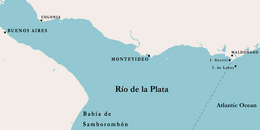Isla de Lobos

North side of the island.
|
|
| Geography | |
|---|---|
| Location | Atlantic Ocean |
| Coordinates | 35°03′01″S 54°52′27″W / 35.05028°S 54.87417°W |
| Total islands | 2 |
| Area | 0.435 km2 (0.168 sq mi) |
| Highest elevation | 26 m (85 ft) |
| Administration | |
| Department | Maldonado |
| Part of | Coastal Islands National Park |
| Administered by | Ministry of Livestock, Agriculture and Fisheries |
| Additional information | |
| Official website | http://www.isladelobos.com.uy |
The Isla de Lobos is a small island located about 8 kilometres (5.0 mi) southeast of Punta del Este (Uruguay). An islet lies east of the island.
The island is an outcropping of rocks as a continuation of the Cuchilla Grande, in an area of the Atlantic Ocean immediately at the mouth (outer limit) of the estuary of Río de la Plata. Administratively, it falls under the jurisdiction of the province of Maldonado, although it constitutes a natural reserve. Somewhat to the northwest is the smaller Gorriti Island which is the secondmost southerly place in Uruguay.
Isla de Lobos was exploited economically until 1992. Hunting the island's marine life was prohibited by law in 1991. Today it constitutes a nature reserve that is integrated into the "Coastal Islands National Park" administered by the Ministry of Livestock, Agriculture, and Fisheries.
It was first documented by Spanish navigator Juan Díaz de Solís in 1516 and named "San Sebastian de Cádiz". In 1527, it was visited by the Venetian navigator Sebastian Cabot during his expedition to the Río de la Plata and Paraná. In 1528, Diego García de Moguer sailed to the region and named it the "Island of the Snapper." In 1599, the island was visited by Laurens Bicker.
In 1858 the Uruguayan government erected a lighthouse on the island, which was rebuilt in 1906. With its height of 59 meters above sea level, From the balcony outside, which is accessed by 240 steps, there is a wonderful panoramic view of the island and the coast of Punta del Este.
In July 2001, it became the first automated lighthouse in Uruguay, using solar energy and other new technology. It has a siren that runs on compressed air to provide an alternative signal on days of thick fog.
...
Wikipedia

